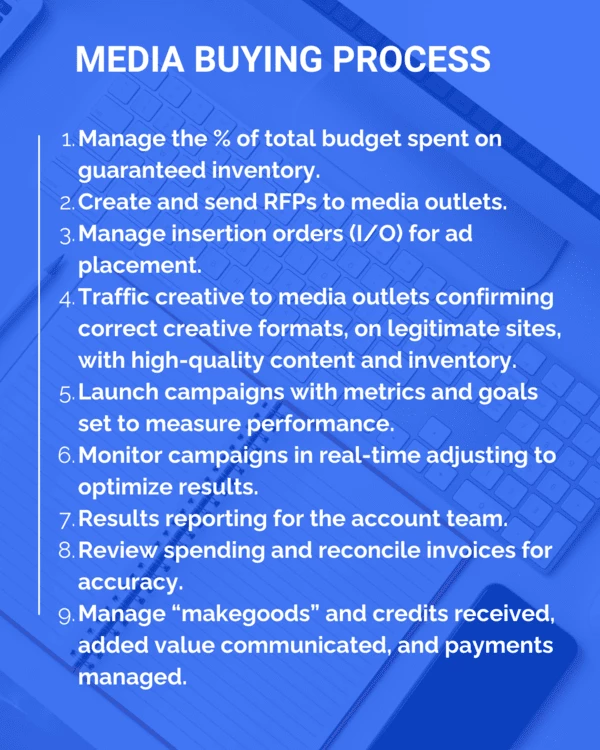If you’re like me, you know a lot about most areas of marketing. You’re what is known as a generalist, well-versed in managing digital marketing, marketing operations, budget management, and maybe even marcom and PR. That doesn’t mean you have hands-on experience with everything, like setting up a paid search campaign, managing programmatic videos, or running marketing analytics. If that sounds like you, and media buying is on your list of only high-level understanding, then get comfortable.
This guide will define media buying and planning, share some key definitions, outline the planning and buying processes, and provide you with important questions to ask the next time you review media agencies.
If helpful you can jump below to learn a few key terms you should understand.
HOW TO GET STARTED WITH MEDIA
Now that you’re a bit more familiar with some media terms, let’s discuss media buying. Media buying is just that, buying media placement for advertising to promote your message. Media buying does not include the entire advertising process. Campaign ideation and ad creative development are separate. Some agencies do ideation, creative, and media buying, and others focus solely on media buying for your advertising campaign.
But before reaching the buying phase, a few steps come first. You will need to share your overall business goals and goals for the specific campaign, your target audience and the KPIs you want to focus on. Know who your campaign message should reach? Having personas is helpful, and sharing them with your media partners will support their research.
Once you’ve assembled that information, the next step involves the planners at your media agency.
WHAT IS MEDIA PLANNING?
A planner knows your audience and will create a customized media plan designed to best engage with them and meet your goals. They know who your customers are, where they go, how they engage with ad channels and their behavior and lifestyle preferences.
A skilled media planner continually researches and learns about the latest media trends, social platform developments, and specialized publishers and channels that will affect ad placement.
If your customer is Gen Z, planners will know that TikTok is an excellent channel to advertise on but that the social media platform has recently seen the highest drop in engagement rate, at 35% YoY. [1] It may still be the best channel for your brand, but your planner will evaluate that based on the most recent data for your specific customers.
Expert planners also know you may want to avoid advertising leading up to a Presidential election when space is limited and costs are high. They know what season or events can affect prices or consumers’ already short attention spans.
With your audience data and budget parameters, they will develop a media mix that delivers the highest performance metrics to reach your assigned goals. Your goals may be building brand awareness, increasing website traffic, video viewing, downloads, or form completions. The media plan they create will include the best channels, reach, and frequency within your budget to match those goals. From the first pitch to ongoing advertising campaigns, your media planner will continually provide the best media plans for your brand.
WHAT IS MEDIA BUYING?
Simply put, media buying is buying media space to place advertising. Media buyers set up placements, times, and frequency and maximize and manage budget spend to reach your goals. A full-service media buying agency will manage traditional and digital ad buys, to support your brand and/or performance goals, including print, linear TV, outdoor (OOH), terrestrial radio, social platforms, streaming services, paid search, and OTT/CTV (direct and programmatic).
The buying team identifies and purchases ad space based on the approved media plan, negotiating costs to get the best CPMs or prices based on pre-determined KPIs, using manual, direct, and programmatic buying practices. Buyers purchase media directly from a publisher or channel, through networks using DSPs, or programmatically using technology to buy and sell digital ads.
They set up campaigns, monitor, test, optimize in real-time, and report on results. The buying team also has a lot of accounting work to manage, reconciling each invoice to the buy to ensure everything runs correctly and as planned. Media buyers will also provide recommendations for future campaigns based on what they have learned. Results must show value and attribution, where possible, and demonstrate the goals reached.

13 QUESTIONS TO ASK A MEDIA AGENCY
Now that you know more about media buying and planning, you may be ready to pull together a short list of possible media agency partners. Once you’ve found your potential partners, you’ll want to set up a time to do an initial meet and greet. The agency should ask questions about you, your company, your culture, and your goals. And there are several questions you should ask to understand better how they manage their business and media buying. They should be transparent with their business structure, fees, and engagement process.
I talked with our agency CEO, Steve Reed, to get his recommended questions marketers should ask potential agency partners.
- Longevity and expertise of the agency team?
- Clients that would be considered competitors.
- How do they manage buys on media platforms, ad exchanges, and DSPs?
- How do they manage ad inventory and placement quality?
- How do they ensure lower CPMs while still providing high-quality placement?
- Do they work with frequency caps, and how do they optimize for budget?
- How are they managing ad fraud?
- Do you use inclusion lists or exclusion lists? (Discuss MFA sites.)
- Do they make additional income from clients and ‘resold’ inventory outside of contracted fees?
- How do they stay ahead of media trends and pass that benefit on to clients?
- How are they different from other media agencies?
- What does their engagement process look like?
- Ask for references and case studies relevant to your business.
Once you have found your new media agency partner, your account team will be your primary contact and will meet with you regularly. They should become a part of your marketing team, not just reporting results but providing ongoing recommendations for improvements. They should be open to answering all questions about your media buying program. Your team may also provide you with beta opportunities from their partners and platforms, and you should be ahead of new media trends to communicate when changes may affect your plans – good or bad.
Working with an experienced media agency allows brands to leverage their expertise and relationships with publishers and platforms to support lower rates and purchase the best ad inventory. They may also acquire added value for you in the form of longer ad runs, additional insertions, or prime locations.
After managing external media teams for many years as a brand marketer, I realized that though I had great partners open to all my questions, there was still plenty I didn’t understand about media buying and how to optimize for our advertising goals. As marketers, we have a lot to manage, and while you can’t be expected to know everything, these definitions will allow you to have educated conversations and ensure you continue to learn from your partners as you grow your advertising program. Vision Media would love to be on your list if you are searching for your next media buying partner. Let’s connect on how our media obsession can power your business results.
Media Terms to Know
Ad Exchange – Virtual marketplace where publishers and advertisers buy and sell ad inventory.
Ad Inventory – Total advertising space a publisher or platform has for sale.
Ad Network – Organizations that connect advertisers with various websites hosting ads.
CTV (Connected TV) – Devices connected to the internet allowing viewers to stream videos.
CPM – Cost per 1,000 ad impressions.
Daypart – Scheduled time segments for radio and television advertising that include daytime, primetime, late night, early morning, and total day
Display Ads – Online advertising that combines text, images, and links to a website.
DSP (Display Side Platform) – Automated ad buying platform where digital ad inventory is purchased.
First-Party Data - Data you collect directly from your owned channels.
Frequency – How many times a viewer sees a specific ad.
Frequency Capping – Ensuring an individual doesn’t see the same ad too often.
Impressions – Each time a website visitor sees a digital ad or ad group.
In-Banner Video – Video creatives that play within a display banner ad on a webpage
Media Arbitrage – The method of buying ad space or traffic at a low cost and then redirecting that traffic to websites where they can monetize the engagement at a higher rate for a profit
Media Mix – How advertising time and resources are distributed across multiple platforms or channels: print, radio, digital, and TV
MFAs—Made for Advertising or Made for Arbitrage—are websites created with poor-quality content and a high number of ads, with most of their traffic coming from paid visitors.
OOH (out–of–home) advertising is advertising outside your home, such as billboards, bus shelters, and other signage.
OTT (Over the Top) – Video content delivered to a viewer via the internet.
Pre-roll video – Video ads that play before video content
Programmatic - The use of technology to buy digital advertising
Streaming audio – Audio streamed over a network rather than from a physical location.
SSP (Supply-Side Platform) – Programmatic technology used by publishers to manage the sale of advertising impressions.
Sources:
[1] https://www.socialmediatoday.c....
https://advertising.amazon.com/library/guides/media-buying
https://www.marketingevolution.com/marketing-essentials/media-buying
https://blog.hubspot.com/marketing/media-buying
Hero image: pexels-cottonbro-studio-5077038





